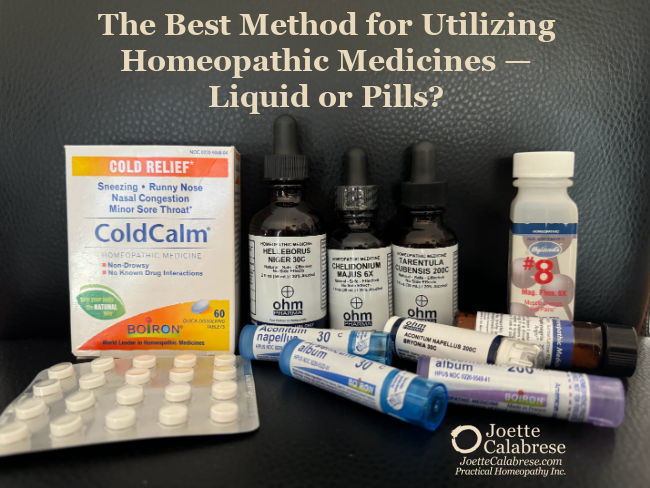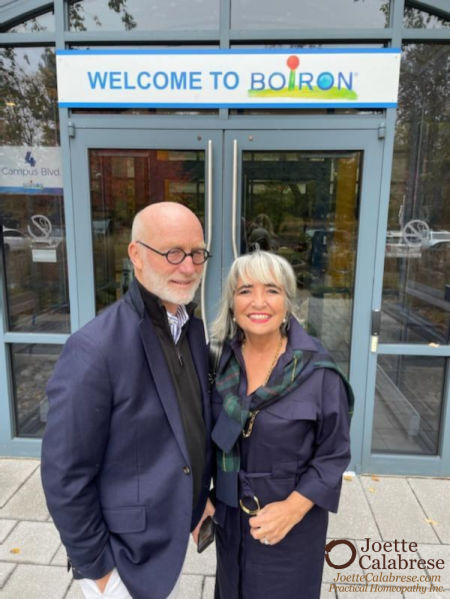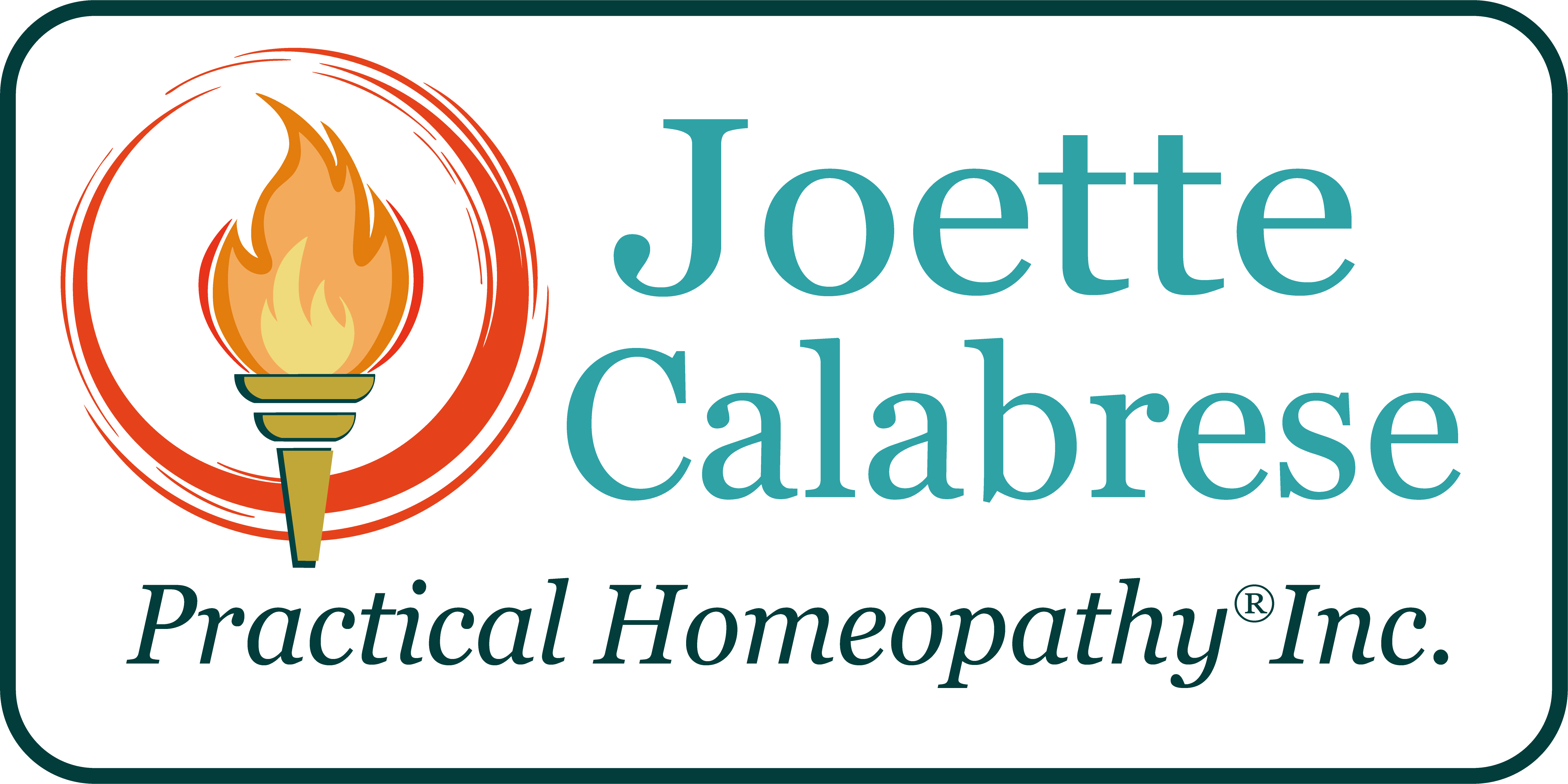Here’s a tricky little riddle for you: When does a well-chosen homeopathic medicine not act?
Answer: When you don’t properly utilize it!
I have a keen sense of stating the obvious, don’t I? But let’s face it, if you don’t own the required remedy, or you own it but don’t utilize it properly, even the most carefully chosen medicine will not act.
I receive questions all the time asking for the best method for utilizing homeopathic medicines. I don’t find the subject that perplexing. However, given the number of varying opinions out there, it might not be very clear to a newcomer. So, let’s clear it up.
Differing Methodologies for Utilizing Homeopathy
-
Powders
Historically, homeopaths utilized homeopathic medicines in a powder form. My Joette’s Mighty Members* learned about that as I read from and commented on Dr. James Compton Burnett’s highly educational and inspirational book, “Fifty Reasons for Being a Homeopath.”
-
Pillules or Tablets
A majority of today’s homeopaths prefer utilizing the medicines manufactured in pills, the tiny little pillules that come in tubes from homeopathic manufacturing pharmacies. Some combination medicines, such as ColdCalm® and cell salts, also come in another dry form, meltaway tablets. Either way, this category of medicine is utilized sublingually, meaning simply popped under the tongue so that the medicines can be absorbed into the bloodstream through the tissues under the tongue. Easy!
Each product's label clearly states the number of pillules considered as one dose. Keep in mind that each manufacturing pharmacy may require a different number of pills. Pay attention to the label! -
Dissolved in Liquid
Other homeopaths prefer dissolving the dry pills in water — a “water dose.” This methodology involves placing a dose of the appropriate homeopathic medicine in a bottle containing 15 ounces of water. Allow the pillules or tablets to dissolve by stirring or shaking (if a water bottle was used). When it’s time for me to administer a dose, I take one capful (about one tablespoon), making sure to shake the bottle ten times before each dose.
-
Manufactured as Liquid
Some protocols may call for the medicine to be manufactured in liquid form. Do not confuse this with the method of dissolving dry medicine in water. No, this type of homeopathic medicine is created by the manufacturing pharmacy to unique specifications — either in a water base or an alcohol base. The form is similar to that of a mother tincture; only the gross substance is diluted and succussed to a specific homeopathic potency.
Follow the Leader
Generally, the medicines I teach in my blog posts are utilized as dry pills. If there is an exception — such as with Mag phos for cramping — I will note it in the post and on the free Remedy Card.
Many of the Banerji Protocols also require dry pillules. However, certain of their protocols may also involve a remedy in liquid form. In their case, this would mean using a homeopathic manufactured in liquid form (as opposed to dissolving dry pillules into a liquid at home).
Joe De Livera (also known as Joepathy) prefers to utilize a water dose (dry pills dissolved in water). He offers specific protocols for creating those water doses.
My belief is to follow the leader. When a homeopath shares how their protocol has been best utilized, I do what they say.
So, even though I generally use dry pillules, what if Joepathy prefers Arnica montana pillules dissolved in water for a specific condition? Then, that’s the way I’ll do it. Thank you, Joe.
If the Banerji Protocol calls for a medicine manufactured as a liquid, then that’s what I will do out of respect for their well-proven methodology.
I’m not here to argue with success. My fellow homeopaths, who also have decades of clinical experience, should be respected.
Besides, homeopathy to the uninitiated can seem complex enough. Why would we choose to add another layer of uncertainty? Do what the homeopath suggests, and don’t reinvent the wheel.
Utilizing Homeopathic Medicines by Stretching Your Inventory
Some students have asked if it’s okay to dissolve their medicines in water to save money by “stretching” their existing inventories.
I ask them, “Is playing with the protocol that has been clinically shown to act reallllllllllly necessary?” (Yes, I put a lot of “Ls” in my use of the word really … for emphasis.)
A new tube of medicine is around ten dollars. If money is tight, give up a fancy coffee. Cancel a streaming service. There are so many ways to save ten dollars so that you can purchase the meticulously manufactured homeopathics from a pharmacy rather than improvising yourself.
However, I’ll grant you one exception:
Alfred was experiencing terrible vomiting. Arsenicum album had always helped, but he only had two pills left. It was Saturday night, and there were no stores open. What is he going to do? Well, in that case, he’s obviously going to try to stretch that remedy until he can procure more.
I’ve mentioned time and time again that you should keep your homeopathic medicine kit up-to-date and ready for any eventuality. But okay, in an instance like this, I can see the need to stretch the medicine by creating a water dose. (And you’ll have learned your lesson for next time.)
Will the stretched water dose be as efficacious as utilizing the protocol? Who knows. But it’s probably better than nothing until you can get the necessary medicine.
Trust Our Homeopathic Pharmacies
My friends, I trust our manufacturing pharmacies. They follow exquisitely detailed regulations, both from the homeopathic pharmacopeia and from the FDA. I have no desire to play junior chemist at home and gamble on the results.
Consequently, I teach my students to follow the protocols exactly as written by the masters. Generally, the protocols I teach involve dry pills administered sublingually. However, if the protocol calls for a water dose, create that as directed. If the protocol calls for a medicine manufactured in liquid, purchase that.
Let’s keep it simple and pass on the good news of Practical Homeopathy®!
Warmly,
*If you’re not yet a Joette’s Mighty Member, you’re missing out on additional educational material I share only in our private enclave. There, I can be more candid and discuss topics I might not be comfortable discussing publicly.
And remember — all my Mighties qualify for a 10% discount on course purchases. If you need assistance getting your discount, email [email protected] for more information.






My one son just started a votech school after being homeschooled. The nurse called me to ask why no advil Tylenol or Benadryl was allowed. I told her homeopathics is what we use. I asked for a form for him to be able to carry it with him. She said I would have to have a doctor note and even then the state doesn’t recognize homeopathic as medicine so I got to thinking that if they don’t consider it medicine then what’s the harm in carrying it. So what if he has a bad allergic reaction to something? All he can have is a cold wash cloth on his head. Can you give any info on this topic. Oh she also said to give it to him before school. I said it’s given symptomaticly not preventative.
I don’t know what your question is.
The nurse at the votech (in Michelle’s comment above) is wrong on 2 counts:
1. Dr. Gundry is a famous heart surgeon who wrote the book, “The Plant Paradox,” a diet book. In it, he explains just how bad Tylenol and Advil are for the body and advises against anyone taking ANY amount of it.
2. Saying that the “state doesn’t recognize homeopathy” is pure nonsense. A FEDERAL law, passed in either 1937 or 1938, gives all Americans the right to use homeopathy. That nurse is interfering with Michelle’s son’s right to use it and that’s illegal.
Lastly, kudos to Michelle for using homeopathy for her family! I wish I had known about it when my children were little, or before.
Thank you, Linda for your info. I was a bit bothered by the nurses comments, and I will continue to do my research and figure out what’s going on over there at the school and I will get my son his histaminium to take with him in his pocket. I also want to thank Mary Cathrine for reaching out to me privately
Greetings. I am a bit confused on this wet dose method. I see here that you recommend a dose per 15 oz water.
However I am seeing a lot of variableness on this topic. Such as:
Joe De Livera states 10 pills per 500 ml water.
Another homeopathy site reads one dose per 1-2 oz water.
I read your statement in the Follow the Leader section and I understand what you mean there. I am talking of using a dose as a ‘wet dose’ form.
That said, Is it correct to say that a dose is a dose is a dose? Such that the amount of water is not so specific?
Thank you for your time.
There are different methods used by different homeopaths. Joepathy’s method is effective and when I use his protocols, I use his method in its entirety.
When using the Banerji Protocol method, I purchase the medicine in water directly from the manufacturing pharmacy.
When there are no specific directions, and Its important to dilute the medicine, I often use a dose in 1-2 ounces of water.
Otherwise, I use dry pellets directly in the mouth.
None have failed me.
When dissolving the dry pellets in water, is there a time length of how long this solution is good for? Is it fine to leave in a plastic spray bottle until it is used up?
Thank you.